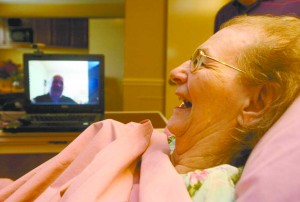
Why is this happening?
According to a report released in September, end-of-life care in the nation must be re-evaluated at every level. (See “Dying in America: Improving Quality and Honoring Individual Preferences Near the End of Life (2014)”, Committee on Approaching Death: Addressing Key End of Life Issues; Institute of Medicine). The 21-member nonpartisan committee examined over-treatment, late referrals to hospice and what is known as “futile care” – aggressive treatments that have no possibility to cure. The committee’s overall conclusion is a call for sweeping change.
“The bottom line is the health care system is poorly designed to meet the needs of patients near the end of life,” said David M. Walker, former U.S. comptroller general and the committee’s chairman. “The current system is geared towards doing more, more, more, and that system, by definition, is not necessarily consistent with what patients want, and is also more costly.”
Have you had the “Conversation”?
Many of the report’s recommendations could be accomplished with commonsense approaches to illness when there is no longer the possibility for cure. An example is encouraging insurers to reimburse health care providers for appointments concerning advance directives with patients. End-of-life planning, both in conversation and in writing, is essential for patients to receive the kind of care they want and for families to gain peace of mind. If a physician does not broach the subject, patients must be their own advocates. Living Wills and the user-friendly FIVE WISHES are full legal documents available for free from Hospice of Marion County. They are simple to complete, require no attorney and are both legal and revocable. The important thing to do is to actually complete the document, provide copies to all involved in one’s health care and keep it in an accessible location in the home (not in a bank safety deposit box).
Other recommendations would require a reversal from emphasis on hospitalization to home care, which is where patients most often indicate they want to be. Financial incentives would need to be scrutinized, as well.
“We know that there may be a need for new legislation to be introduced to accomplish that, and we recognize that that’s harder to accomplish in a politically charged environment,” said Dr. Philip A. Pizzo, former dean of the Stanford University School of Medicine and the committee co-chairman.
Dr. Pizzo also referred to a recent survey of doctors about their own end-of-life preferences, which showed that “a vast majority want to be at home and as free of pain as possible, and yet that’s not what the doctors practice on their patients.”
Meeting a Patient’s Needs
Further the panel pointed the finger at medical schools, calling for greatly increased training in palliative care and setting standards so that more clinicians know how to compassionately and effectively treat patients who choose to be made comfortable with hospice care and avoid extensive and useless medical procedures.
“If you meet their needs, treat their pain, treat their depression, get them some help in the house, your costs plummet,” said Dr. Diane E. Meier, a committee member and the director of the Center to Advance Palliative Care. Fewer patients would end up in emergency rooms getting expensive care they do not want, she said, adding, “It’s a rare example in health policy of doing well by doing good.”
Dr. Meier’s program was the inspiration for Hospice of Marion County’s palliative consulting service launched in 2007. Today HMC’s is a nationally recognized model for others, consulting in all area hospitals and with physicians. Marion County’s palliative team members are experts in pain management and symptom control. Fifty percent of the patients they see are referred to hospice care due to the severity of their condition, but the other 50 percent may recover well, once their pain and symptoms are managed.
A Look at Today’s Headlines
Two glaring contrasts often grab the media’s attention: 1. Long “battles” with disease, endless treatments, relapses, recurrences and eventual death in the ICU, or 2. States with Death with Dignity laws (Oregon, Washington, and Vermont), which is where a 29-year-old woman with brain cancer has moved to end her life in her own time. The brave story of Brittany Maynard puts the question on the front page.
Hospice of Marion County offers a third alternative: When cure is no longer an option, comfort care is the answer. There is no need to suffer the effects of either disease or the side-effects of treatment. Palliative medicine addresses both the physical, as well as emotional, mental and social needs of the patient, as well as supportive measures for the entire family. The holistic compassionate approach of hospice is unique in the medical world but could well be the model of care recommended by the Dying in America committee to change the way we live …and die.
Hospice of Marion County
352-873-7400
www.hospiceofmarion.com
 Central Florida Health and Wellness Magazine Health and Wellness Articles of the Villages
Central Florida Health and Wellness Magazine Health and Wellness Articles of the Villages



